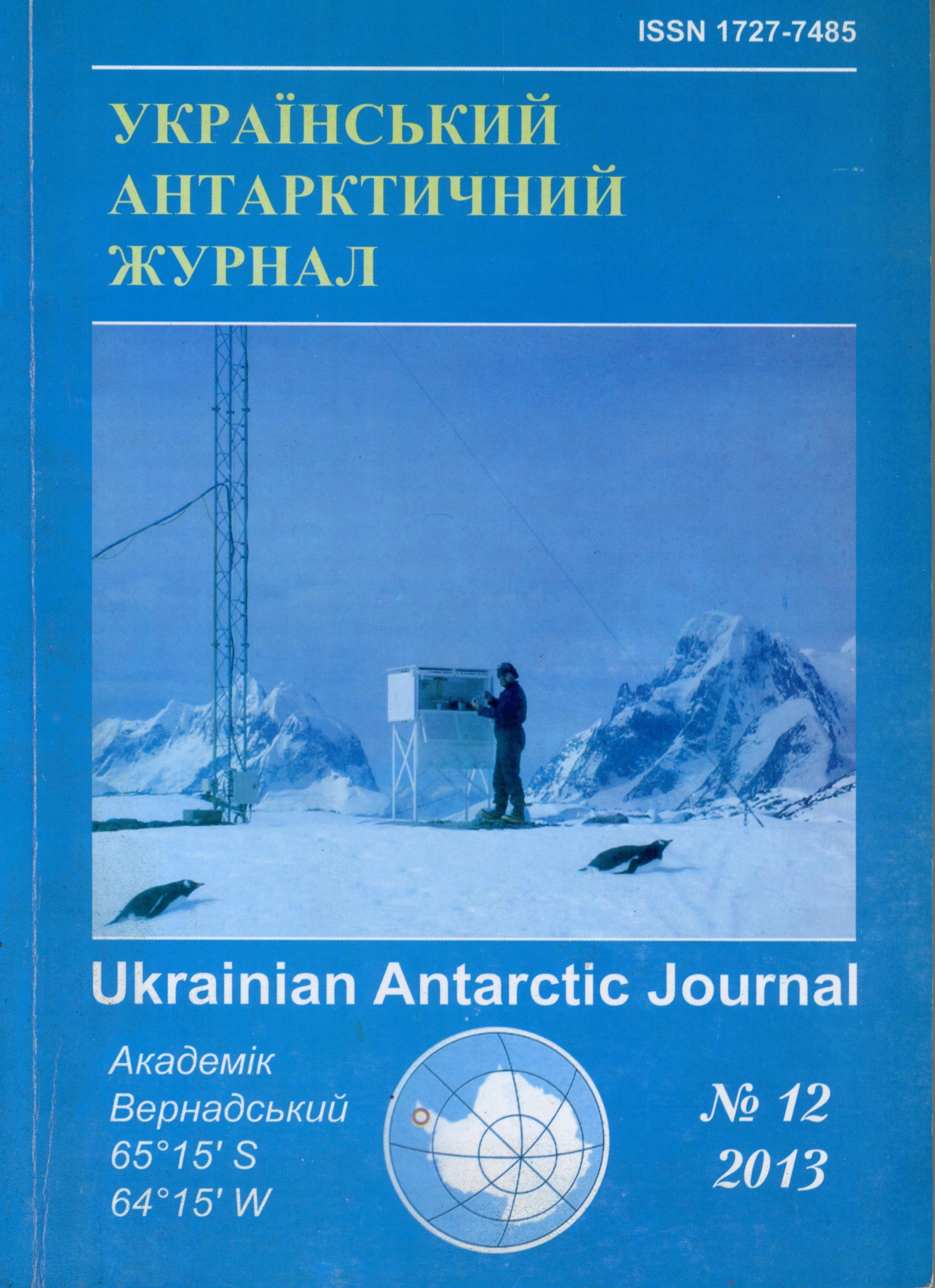The parameters of Deschampsia antarctica population success comparative analyses in the region of Admiral bay (King-George island. The Inshore of Antarctica)
- Deschampsia antarctica,
- parameters of Deschampsia antarctica population success,
- maritime Antarctica
Abstract
There are necessity (need) of vascular plant population success monitoring in Antarctica under warming condition. However, question about correlation between population success by different indices hasn’t been settled. The six Deschampsia antarctica populations have been investigated during the 2005/06 season in the region of Admiralti Bay (King-George Island) by series population success indices: individual cover or abundance, some biometric parameters and DNA relative content in nucleus of cell parenchyma foliage. Extremal grouping of quantitative comparison in pairs of these indices for studed D.antarctica populations has been to allow each compared pair locality to select groups with significant positive correlation between investigated indices and groups with significant negative correlation or central tendency to it. The population success in the case of positive correlation by part of indices have been determined to correlate to another part of its. In the case of negative correlation populations probability select strategy when increase in value of one parameter have been accompanied by decrease in value of another same. Populations with identical success by all investigated parameters have been selected to form specific clasters of complex population success. Monitoring of antarctic vascular plant population states (for example, D.antarctica) has been concluded to be conducted by as more as possible number of success parameters and to be estimated optimal conduction by search of correlation between every investigated parameters
References
- Ajvazyan, S.A., Buxshtaber, V.M., Enyukov, I.S., & Meshalkin, L.D. (1989). Prikladnaya statistika. Klassifikaciya i snizhenie razmernosti [Applied statistics. Classification and reduction of dimensionality]. Moscow, Finansy` i statistika.
- Vul`f, E.V. (1937). Poliploidiya i geograficheskoe rasprostranenie rastenij [Polyploidy and the geographic range of the plants]. Uspexi sovremennoj biologii, 7, 161–197.
- Kunax, V.A. (2011). Zhebrakovskie chteniya. III. Ontogeneticheskaya plastichnost` genoma kak osnova adaptivnosti rastenij [Zhebrakov Readings. III. Ontogenetic plasticity of the genome as the basis of plants’ adaptivity]. Institut genetiki i citologii NAN Belarusi. Minsk. Pravo i e`konomika.
- Miriuta, N.Iu., & Kunakh, V.A. (2011). Dynamika klitynnykh system in vitro. 2. Orhanizatsiia u chasi i stiikist yak systemy kultury tkanyn rauvolfii zmiinoi na pasazhnomu rivni [Dynamic of cell population systems in vitro. 2.Temporal organization and robustness of Rauwolfia serpentina Benth. culture tissues system at passage level organization]. Biotekhnolohiia, 4(6), 16–29.
- Pollard, Dzh. (1982). Spravochnik po vy`chislitel`ny`m metodam statistiki [A handbook of numerical and statistical techniques]. Moscow, Finansy` i statistika.
- Strogonov, B.P. (1973). Rastitel`ny`j metabolizm v usloviyax zasoleniya [Plant metabolism under saline pollution]. Materialy` XXXIII Timiryazevskix chtenij. Moscow, Nauka.
- Churaev, R.N. (2006). E`pigenetika: genny`e i e`pigenny`e seti v onto-i filogeneze [Epigenetics: gen and epigen networks in the onto- and phylogenesis]. Genetika, 42(9), 1276–1296.
- Convey, P. (2003). Maritime Antarctic climate Change: Signals from terrestrial biology. Antarctic Research Series, 79, 145–158.
- Convey, P. (1996). Reproduction of Antarctic vascular plants. Antarctic Science, 8(2), 127-134.
- Day, A.T., Ruhland, C.T., & Xiong, F.S. (2008). Warming increases aboveground plant biomass and C stock in vascular-plant-dominated Antarctic tundra. Global Change Biology, 14, 1827–1843.
- Fowbert, J.A., & Smith, R.L. (1994). Rapid population increases in native vascular plants in the Argentine Islands Antarctic Peninsula. Arctic and Alpine Research, 26, 290–296.
- Gielwanowska, I. (2005). Specyfika rozwoju antarkctycznych roslin naczyniowych Colobanthus quitensis (Kunth) Bartl. i Deschampsia antarctica Desv. Rozprawa habylitacijna. Wydawnictwo Uniwersitetu Warminsko-Mazurskiego, Olsztyn.
- Grime, J.P. (2002). Plant strategies, vegetation processes, and ecosystem properties. Second edition. John Wiley & Sons.
- Korsun, S., Kozeretska, I., Parnikoza, I., Sharivska, L., Lugovska, K., & Klimenko, I. (2008). Effect of natural and anthropogenic factors on the chemical composition of soils of the King George in the maritime Antarctica Agroecological Journal, 4, 20–25.
- Parnikoza, I.Yu., Loro, P., Miryuta, N.Yu., Kunakh, V.A., & Kozeretska, I.A. (2011). The influence of some Environmental factors on Cytological and Biometric parameters and Chlorophyll content of Deschampsia antarctica Desv. in maritime Antarctic. Cytology and Genetics, 45(3), 170–176.
- Parnikoza, I., Convey, P., Dykyy, I., Trokhymets, V., Milinevsky, G., Tyschenko, O., Inozemtseva, D., & Kozeretska, I. (2009). Current Status of the antarctic herb tundra formation in the Central Argentine Island. Global Change Biology, 15, 1685–1693.
- Parnikoza, I., Miryuta, N., Mazur, M., Maidanyuk, D., & Kozeretska, I. (2005). Interpopulation heterogeneity of Deschampsia antarctica Desv. according to the variability of nucleas areas and the relative level of DNA in different tissues of leaves. Ukrainian Antarctic Journal, 3, 128–134.
- Parnikoza I.Yu., Inozemtseva D.M., Tyschenko O.V., Mustafa O., Kozeretska I.A. Antarctic herb tundra colonization zones in the context of ecological gradient of glacial retreat . Ukrainian Botanical Journal. –2008. –V. –V.65.–P.504–511.
- Parnikoza, І.Yu., Мiriuta, N.Yu., Аl-Ammouri, Yu., & Kunakh, V.А. (2008). Rauwolfia serpentina Benth. Cell populations dynamic in the context of different cultivation conditions in vitro. Biopolymers and Cell, 24(4), 300–309.
- Parnikoza, I.Yu., Miryuta, N.Yu., Maidanyuk, D.N., Loparev, S.A., Korsun, S.G., Budzanivska, І.G., Shevchenko, Т.P., Polischuk, V.P., Кunakh, V.А., & Kozeretska, I.А. (2007). Habitat and leaf cytogenetic characteristics of Deschampsia antarctica Desv. in Maritime Antarctic. Polar Science, 1, 121–127.
- Smith, R.I.L., & Corner, R.W.M. (1973). Vegetation of the Arthur Harbour –Argentine Islands region of the Antarctic Peninsula Br. Antarct. Surv. Bull., 33&34, 89–122.
- Turner, J., Colwell, S.R., Marshall, G.J., Lachlan-Cope, T.A., Carleton, A.M., Jones, P.D., Lagun, V., Reid, P.A., & Iagovkina, S. (2005). Antarctic climate change during the last 50 years. International Journal of Climatology, 25, 279–294.
- Vera, M.L. (2011). Colonization and demographic structure of Deschampsia antarctica and Colobanthus quitensis along an altitudinal gradient on Livingston Island, south Shetland Islands, Antarctica. Polar research, 30, 7146.
- Westhoff, V., van der Maarel, E. (1973). The Braun-Blanquet approach. In: Whittaker, R.H. (Ed.) Handbook of vegetation science, part 5, Classification and ordination of communities, 617–726.

